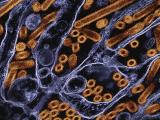Sep 14, 2011
Study: H1N1 flu self-diagnosis not accurate
Not only was self-diagnosis of flu inaccurate during the 2009 H1N1 influenza pandemic, but following national guidelines on symptoms for case definition did not improve the accuracy of self-diagnosing, according to a New Zealand study. The researchers used cross-sectional survey data to correlate flu self-diagnosis with serologic confirmation of 2009 H1N1. Sera and survey data were collected from November 2009 through March 2010, 3 months after the country's first pandemic wave. Data analyzed were from 318 children, 413 adults, and 423 healthcare workers. Among adults, 23.3% who reported having influenza were seropositive for the disease (hemagglutination inhibition titers of 1:40 or higher), compared with 21.3% for those who believed they didn't have flu. In addition, adults meeting New Zealand surveillance or Ministry of Health influenza case definitions were more likely to believe they had the flu (odds ratio [OR], 27.1; 95% confidence interval [CI], 13.6-53.6), but their symptom profiles were not associated with a higher likelihood of H1N1 seropositivity (OR 0.93; 95% CI,0.5-1.7). The authors conclude, "These findings raise challenges for public health initiatives that depend on accurate self-diagnosis by members of the public and appropriate self-management action."
Sep 12 BMJ Open study
Minnesota ducks harbor many avian flu strains
Avian flu was detected in 9% of ducks in northwestern Minnesota in July through October 2007 and in 18% of ducks in the same period in 2008, according to a study published yesterday in PLoS One, and the strains detected ran the gamut. Using cloacal swabbing, US researchers detected avian flu in 222 of 2,441 ducks (9.1%) in 2007 and in 438 of 2,452 (17.9%) ducks in 2008, with a peak incidence in late summer of both years. Almost two thirds of birds sampled were mallards. Theresearchers detected 27 avian flu subtypes during 2007 and 31 during 2008. Ten of the 16 hemagglutinin (HA) subtypes were detected each year (H1, 3-8, and 10-12 during 2007; H1-8, 10, and 11 during 2008), and all neuraminidase (NA) subtypes were detected both years. Subtype diversity each year increased in prevalence into September. Predominant subtypes in 2007 were H1N1, H3N6, H3N8, H4N6, H7N3, H10N7, and H11N9 and in 2008 were H3N6, H3N8, H4N6, H4N8, H6N1, and H10N7. The study found that mallards had the highest prevalence of avian flu, and that testing only juvenile mallards would suffice for surveillance purposes.
Sep 13 PLoS One study



















